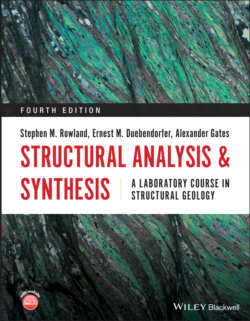Читать книгу Structural Analysis and Synthesis - Stephen M. Rowland - Страница 22
2 Outcrop Patterns and Structure Contours Objectives
ОглавлениеDetermine the general attitudes of planes from outcrop patterns.
Draw structure‐contour maps.
Solve three‐point problems.
Determine outcrop patterns of planar layers from attitudes at isolated outcrops.
Determine the nature of contacts from outcrop patterns and attitudes.
Determine stratigraphic thickness from outcrop pattern.
One of the primary roles of a geologist is to quantitatively determine subsurface structural relations from surface and/or well data. Your skills to address this will be developed starting with planar features and progressing to more complex structures. Planar structural elements such as contacts between monoclinal beds, dikes, and faults form irregular outcrop patterns on the uneven earth's surface. In situations where strike and dip symbols are not provided (such as on regional, small‐scale maps), outcrop patterns can serve as clues to the orientations of the planes. These relations should also be used for constructing maps from field data. The following are seven generalized cases showing the relationships between topography and the outcrop patterns of planes as seen on a map. As you examine Figures 2.1–2.7, cover the block diagram (parts a) and try to visualize the orientation of the bed from its outcrop pattern in map view (parts b). Note the strike and dip symbols that indicate orientation.
1 Horizontal planes/contacts parallel topographic contour lines. They also “V” or point upstream but this is not unique (Figure 2.1).
2 Vertical planes/contacts are not deflected at all by valleys or ridges (Figure 2.2).
3 Moderate to steeply inclined planes “V”/point opposite to the direction of dip across horizontal or shallowly inclined ridges (Figure 2.3).
4 Planes/contacts that dip upstream also “V” upstream (Figure 2.4).
5 Planes/contacts that dip downstream at the same dip angle as the stream gradient appear parallel to the stream bed (Figure 2.5).Figure 2.1 Horizontal layer in a stream valley. (a) Block diagram. (b) Map view.Figure 2.2 Vertical layer strikes perpendicular across a ridge and valley. (a) Block diagram. (b) Map view.Figure 2.3 Inclined layer strikes perpendicular across a horizontal ridge. (a) Block diagram. (b) Map view.
6 Planes/contacts that dip downstream at a gentler angle than the stream gradient “V”/point upstream (Figure 2.6).
7 Planes/contacts that dip downstream at a steeper angle than the stream gradient (the usual case) “V”/point downstream (Figure 2.7).
Figure 2.4 Inclined layer dipping upstream that flows 90° to strike. (a) Block diagram. (b) Map view.
Figure 2.5 Layer dipping parallel to stream gradient (perpendicular strike). (a) Block diagram. (b) Map view.
Figure 2.6 Layer dipping downstream more gently than the stream gradient with strike perpendicular to stream. (a) Block diagram. (b) Map view.
Figure 2.7 Layer dipping downstream more steeply than the stream gradient; stream perpendicular to strike. (a) Block diagram. (b) Map view.
